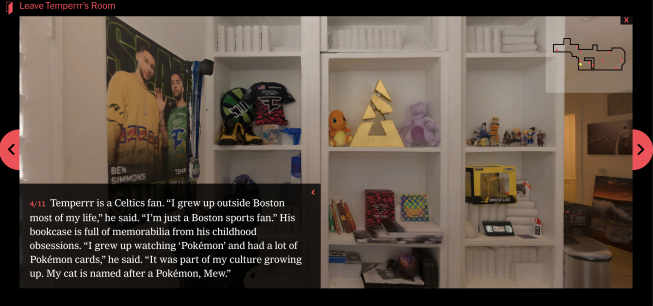The other side with photogrammetry: How Taylor Lorenz went behind the camera with some of LA’s most illustrious influencers
Taylor Lorenz is no stranger to the enigmatic world of social media. Having jump-started her journalistic career writing for the Atlantic and the Daily Beast, Lorenz, 35, moved into the realm of internet culture and technology before landing her position as a full-time reporter at the New York Times. In 2020, Fortune magazine included her in their 40-under-40 listing.
Last October, Lorenz worked with a team of designers to create an immersive, visually driven story that pulled back the curtain on the lives of influencers. Using photogrammetry, Lorenz and her team visually modeled the bedrooms of FaZe Temperrr and FaZe Kay, two members of the Los Angeles-based esports conglomerate, FaZe Clan.
Storybench spoke with Lorenz about the making of this project, “The New Corporate Campus,” and the impact of digital storytelling in modern journalism.
This interview has been edited and condensed.
Why did you first become interested in reporting on tech and internet culture?
I created a bunch of popular Tumblrs. Back in 2009 and 2010, I was a popular person on Tumblr, and that led to me eventually getting into media. When I was making these Tumblrs and running this network that I created, sometimes journalists would write about stuff that I was involved in or they wrote about my friends who, at the time, were YouTubers, and I sort of hated the way that they talked about the internet. It was really corny and, sort of, condescending, and so I thought that I wanted to be a reporter that wrote about internet culture but took it seriously and didn’t talk down to people because they were making stuff on YouTube or somewhere else.
How do you normally find your stories?
Honestly, I spend a lot of time online, and I see what is getting shared and talked about. I also talk to a lot of people in the entertainment and media industry, so I talk to a lot of Hollywood agents and people that work with big-time influencers, things like that. I write a lot about these tech platforms — Tiktok, Twitch, YouTube — and so part of my job is also speaking to them and them sort of saying, “Hey, this is a really big thing right now or this is really popping off right now.” I had attended the Fortnight World Cup in New York, maybe a year before I wrote The New Corporate Campus and, you know, FaZe Clan was something I had written about a lot. And I was just thinking I spend a lot of time with these guys, and it would be cool to do a project highlighting where they live. So I think I just came to that story because I really want to write about FaZe. I had written this profile of FaZe Clan months before, when they were in a different house, and I knew that they’d moved. I feel like sometimes when you write a profile, it’s hard to get a sense of the spaces that these people really live in, and so I wanted to do this interactive tour of their whole campus. Of course, it ended up being way too expensive, so [the editors] were like, “OK, you can do two rooms.”
It’s awesome that you’ve had this ongoing relationship with them. It definitely seems like you’re setting out to make them feel heard and to take them seriously, which I’m sure they appreciate.
Yeah! A lot of them have been famous for several years now, so they’re definitely more cautious of their image. I’ve known Tommy [FaZe Temperrr] and Frazier [FaZe Kay] for a while so they were comfortable talking about everything. That’s the premise of my whole beat, and I’m also one of the oldest reporters on this beat, so I think people know me because I’ve been around for a long time. Just spending a lot of time with sources, no matter what your beat, will allow them to get more comfortable with you.
“I wanted to be a reporter that wrote about internet culture but took it seriously.”
Taylor Lorenz, New York Times technology reporter
How long did this project take you from beginning to end?
Let’s see. How long did it take? It took a little while because they had to go photograph everything. So Tracy Ma, who is in charge of our graphics team, helped orchestrate the photography part of it, because they had to take like 10,000 photographs for each room to make it seem 3D. I think it was three months total. We had to work with this new kind of technology, and so it just required a lot of coordination. We had this vision, and we pitched it. And then [my editors] were like, “OK, well, given how expensive this is you can only do two rooms.” So Tracy worked with the videographers and photographers to make sure that we had the right assets to put it together. She’s in charge of the technical side of it and so she worked to get it all stitched together and then build the custom article page. It was a cool project though! I definitely think it allows you to see a little bit deeper. You don’t always capture it in a photograph, and I feel like it really gave you a sense of these people’s living space.
What made you settle on this kind of visual to use alongside the story?
We wanted something that would really show inside the space. I think the original concept was to do this whole tour so that you could really move through the whole campus and the house, but it was just so expensive. From there, we wanted to make it feel like you could move through their room and see little things like the drawing on Frazier’s walls, the doodles and things. Maybe you would have a line about that in an article, but you can’t really peek around and look and find easter eggs and different things like that.
What was your favorite part of telling this story?
It was really cool to see that they had the profile that I wrote on the wall because I was like, “Wow, it really meant something to them!” It was interesting to get a sense of what people value and the different things that they collect and what’s meaningful to them by looking inside their living space. And so I really liked that as well.
This article was published in late 2020. How did COVID-19 affect the making of this story, if at all?
It definitely did. We had to be really safe because we were sending photographers in. We sent them in when the boys were out of town. But we basically just sent these two videographers, photographers, in to do all of the photos, and then we did the interviews remotely. I did them over Zoom and Facetime where they [FaZe Temperrr and FaZe Kay] kind of like showed me around the room, and I asked about stuff.
How do you see photogrammetry playing into the future of journalism?
I think right now the lift is heavy and it’s hard. We have to take thousands of photographs to really create this experience. As camera technology evolves and video recording technology evolves — for instance, with these like 360 cameras that people have now — I think it’ll become easier to do. You can think of so many different applications. A lot of the time at the New York Times they’ll test out these new types of technology on more feature-y, low-stakes projects. I also write for the Style section, so we’ll test on things like that and then maybe use it in a more intense situation, for instance, building something like a fallout shelter. But this was a really good test case of the types of stuff that we can do.
I read in your Forbes magazine “40 Under 40” article — congratulations, by the way — that you’re really great at spotting internet trends. What is your secret?
Oh my gosh, the secret is to just spend a lot of time online! I think the best thing to do is to consume as much as possible. I think that the more content you can hoover up, the better you can be at identifying trends with it. If you only spend a little bit of time online, you don’t get a sense of the breadth of what’s happening or the mood on the internet, so it’s just important to spend as much time as possible in your realm. I think that’s true for any beat too, you know, to really become an expert in the space, and to really know the space you have to dedicate a lot of time to it. Luckily that requires, for my job, dedicating a lot of time to the internet, which is a fun way to spend your time.
How much time do you spend more or less every day? And do you kind of move between apps — Twitter, Tiktok, Instagram?
Yeah! I’m on Twitter, Tiktok, Instagram, YouTube, really anything. I spend a lot of time on messaging apps as well. I’m on Discord, actually, probably a huge amount. From the time I wake up to the time I go to sleep, probably like most people, I’m online. My working hours are during the day, but a lot of stuff I end up seeing in the middle of the night, and it gives me an idea for the next day. I don’t really have a time when I’m working and a time when I’m not working.
Are there any trends that you’re noticing in the realm of digital journalism?
That’s a very good question. One trend that I’m noticing is a lot of people starting Substack newsletters. Substack is an email newsletter platform that’s become very popular with journalists and writers, and there’s a bunch of high-profile journalists that have left different institutions and gone to Substack. I’ve noticed that it’s a place where more up-and-coming writers are developing their own voice and audience. Established writers are also leaving traditional media jobs and going to Substack.
Is there a reason that it’s so much more attractive to them?
I think it allows you to have direct access to your audience, and also you’re monetized directly. So, at a news organization, you get paid a salary. But say you end up developing an audience of 2 million people. Well, you’re just going to get paid the same as the person that only has 20 readers or something, you know? But with a newsletter, if you charge your readers $5 a month, and you have 2 million readers that want to pay $5 a month, that money goes directly towards you. So it’s just a bigger upside.





